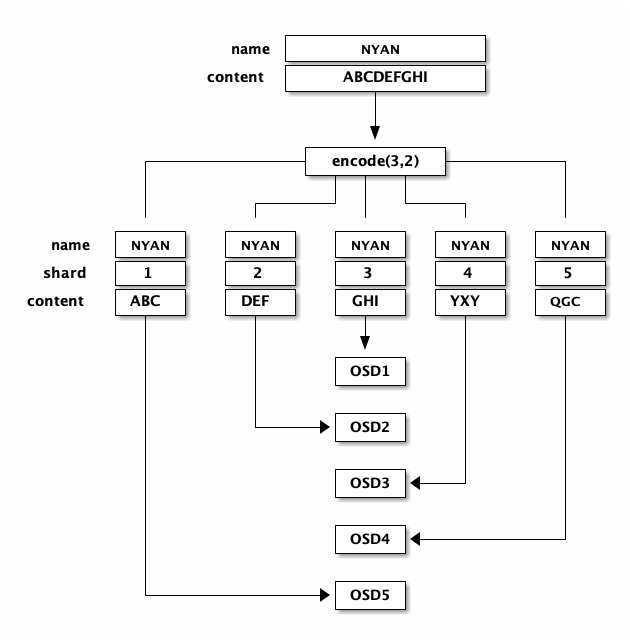Erasure code¶
A Ceph pool is associated to a type to sustain the loss of an OSD (i.e. a disk since most of the time there is one OSD per disk). The default choice when creating a pool is replicated, meaning every object is copied on multiple disks. The Erasure Code pool type can be used instead to save space.
Creating a sample erasure coded pool¶
The simplest erasure coded pool is equivalent to RAID5 and requires at least three hosts:
$ ceph osd pool create ecpool 12 12 erasure
pool 'ecpool' created
$ echo ABCDEFGHI | rados --pool ecpool put NYAN -
$ rados --pool ecpool get NYAN -
ABCDEFGHI
Note
the 12 in pool create stands for the number of placement groups.
Erasure code profiles¶
The default erasure code profile sustains the loss of a single OSD. It is equivalent to a replicated pool of size two but requires 1.5TB instead of 2TB to store 1TB of data. The default profile can be displayed with:
$ ceph osd erasure-code-profile get default
directory=.libs
k=2
m=1
plugin=jerasure
ruleset-failure-domain=host
technique=reed_sol_van
Choosing the right profile is important because it cannot be modified after the pool is created: a new pool with a different profile needs to be created and all objects from the previous pool moved to the new.
The most important parameters of the profile are K, M and ruleset-failure-domain because they define the storage overhead and the data durability. For instance, if the desired architecture must sustain the loss of two racks with a storage overhead of 40% overhead, the following profile can be defined:
$ ceph osd erasure-code-profile set myprofile \
k=3 \
m=2 \
ruleset-failure-domain=rack
$ ceph osd pool create ecpool 12 12 erasure myprofile
$ echo ABCDEFGHI | rados --pool ecpool put NYAN -
$ rados --pool ecpool get NYAN -
ABCDEFGHI
The NYAN object will be divided in three (K=3) and two additional chunks will be created (M=2). The value of M defines how many OSD can be lost simultaneously without losing any data. The ruleset-failure-domain=rack will create a CRUSH ruleset that ensures no two chunks are stored in the same rack.

More information can be found in the erasure code profiles documentation.
Erasure coded pool and cache tiering¶
Erasure coded pools require more resources than replicated pools and lack some functionalities such as partial writes. To overcome these limitations, it is recommended to set a cache tier before the erasure coded pool.
For instance, if the pool hot-storage is made of fast storage:
$ ceph osd tier add ecpool hot-storage
$ ceph osd tier cache-mode hot-storage writeback
$ ceph osd tier set-overlay ecpool hot-storage
will place the hot-storage pool as tier of ecpool in writeback mode so that every write and read to the ecpool are actually using the hot-storage and benefit from its flexibility and speed.
It is not possible to create an RBD image on an erasure coded pool because it requires partial writes. It is however possible to create an RBD image on an erasure coded pools when a replicated pool tier set a cache tier:
$ rbd create --size 10G ecpool/myvolume
More information can be found in the cache tiering documentation.
Glossary¶
- chunk
when the encoding function is called, it returns chunks of the same size. Data chunks which can be concatenated to reconstruct the original object and coding chunks which can be used to rebuild a lost chunk.
- K
the number of data chunks, i.e. the number of chunks in which the original object is divided. For instance if K = 2 a 10KB object will be divided into K objects of 5KB each.
- M
the number of coding chunks, i.e. the number of additional chunks computed by the encoding functions. If there are 2 coding chunks, it means 2 OSDs can be out without losing data.
